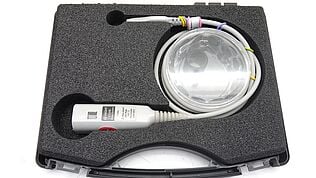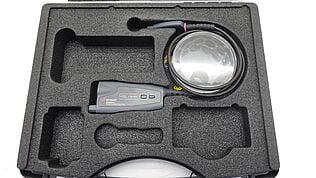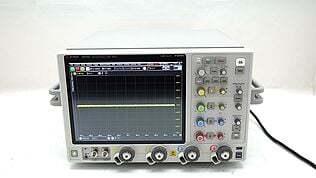- Introduction
- What Is Sampling Rate?
- Nyquist-Shannon Sampling Theorem
- Aliasing
- Data Integrity
- How Sampling Rate Affects Quality
- Oscilloscopes for Signal Analysis
- Resolution
- Accuracy
- Storage
- Factors Influencing Sampling Rate
- Signal Complexity
- Bandwidth
- Optimizing Sampling Rate
- Start with Nyquist
- Analyze Application
- Storage Evaluation
- Test Under Realistic Conditions
- Conclusion
- Whenever You’re Ready, Here Are 5 Ways We Can Help You
Did you know that the sampling rate directly governs how well your digital equipment will represent a continuous analog signal?
A poorly chosen sampling rate could not only degrade signal quality but also lead to misleading data and erroneous conclusions.
This makes the concept of sampling rate far more than a technical specification—it's a crucial design decision that impacts the performance and reliability of your entire digital signal processing system.
Dive in to discover why this concept is the linchpin of digital signal processing.
What Is Sampling Rate?
Sampling rate, often denoted by \(f_{s}\) refers to the number of samples acquired per second from a continuous analog signal.
Engineers commonly measure it in Hertz (Hz). The higher the sampling rate, the better the digital representation of the analog signal will be. However, higher sampling rates demand more computational power and storage capacity.
Understanding how to balance these factors is crucial for anyone working in the field of digital signal processing.
Units
- Hertz (Hz)
- Kilohertz (kHz)
- Megahertz (MHz)
- Gigahertz (GHz)
| Key Takeaway |
|---|
| Sampling rate is a critical factor that dictates the accuracy and reliability of digital representations of analog signals. Optimizing it requires a nuanced balance between theoretical guidelines like the Nyquist rate and practical constraints such as hardware capabilities and application requirements. |
Get the Best Deals on Used Oscilloscopes
Nyquist-Shannon Sampling Theorem
The Nyquist-Shannon Sampling Theorem establishes an essential framework for converting continuous analog signals into digital samples.
According to the theorem, for a complete and accurate digital representation of an analog signal, you must sample at a rate that is at least twice the highest frequency component present in the analog signal. This rate is known as the Nyquist rate.
Aliasing
Sampling at a rate below the Nyquist rate can introduce a phenomenon known as aliasing. In aliasing, higher-frequency components in the analog signal mask themselves as lower frequencies in the digital signal. This distorts the digital representation, making it unreliable for further analysis or processing.
Data Integrity
When you don't adhere to the Nyquist rate, you risk compromising data integrity in several ways:
- Loss of high-frequency information: A low sampling rate filters out the high-frequency components of the signal, leading to an incomplete representation.
- Signal reconstruction errors: Violating the Nyquist criterion makes it mathematically impossible to perfectly reconstruct the original analog signal from its digital representation. This is especially problematic in applications like audio processing or medical imaging, where fidelity to the original signal is crucial.
- Inaccurate measurements: In engineering tasks involving oscilloscopes or other testing equipment, a poor choice of sampling rate can yield incorrect frequency, amplitude, or phase information. This could result in wrong conclusions or inappropriate actions taken based on the faulty data.
- Computational complications: Some digital signal processing techniques assume that the sampled data accurately represents the original signal. A suboptimal sampling rate could therefore interfere with subsequent processing steps, such as filtering or Fourier analysis.
By adhering to the Nyquist-Shannon Sampling Theorem, you ensure that the digital signal holds enough information for accurate analysis and reconstruction of the original analog signal.
This adherence is crucial for maintaining the integrity and reliability of the data across various applications in digital signal processing.
How Sampling Rate Affects Quality
| Low Sampling Rate | High Sampling Rate | |
| Signal Fidelity | Low fidelity, prone to data loss | High fidelity, accurate representation |
| Storage | Requires less storage space | Requires more storage space |
| Processing | Less computational power needed | More computational power needed |
| Bandwidth | Limited bandwidth, less information | Wider bandwidth, more information |
Oscilloscopes for Signal Analysis
Oscilloscopes serve as a quintessential tool for electrical engineers and other professionals in fields requiring signal analysis. When using an oscilloscope, the sampling rate has a profound impact on several key performance metrics.
Resolution
Higher sampling rates provide better time resolution. Time resolution refers to the smallest time interval between two adjacent samples that the oscilloscope can accurately measure.
With a higher sampling rate, you can closely inspect signal details, making it easier to identify anomalies like glitches or transients that occur over short time spans.
Accuracy
A higher sampling rate also offers a more accurate representation of high-frequency components in the signal. This is particularly crucial when you are working with complex signals containing a wide range of frequency components.
A high sampling rate ensures that even the quickest fluctuations in the signal get accurately captured, thereby avoiding the pitfalls of aliasing and data loss.
Storage
High sampling rates invariably demand a larger memory depth in the oscilloscope. Memory depth refers to the number of samples the oscilloscope can store in a single acquisition cycle.
Let's delve into why this matters:
- Longer signal capture: A larger memory depth allows for longer time periods of the signal to be captured and analyzed. This is particularly useful in applications requiring a detailed look into long sequences of a signal.
- Data overflow risks: When the oscilloscope's memory depth is insufficient, you risk data overflow. In such scenarios, the oscilloscope might overwrite older samples, leading to a loss of valuable signal data.
- High-resolution analysis: More storage allows for high-resolution analysis over extended periods. This can be indispensable for applications like debugging communication protocols, where both the macroscopic sequence and microscopic details are important.
- Trade-offs: Larger memory depth often comes at the cost of more expensive hardware and potentially slower data processing times, owing to the larger volumes of data to be analyzed.
By understanding the relationship between sampling rate and these performance metrics, you can make informed choices that balance resolution, accuracy, and storage needs.
This allows you to fully leverage the capabilities of your oscilloscope in diverse testing and measurement scenarios.

Factors Influencing Sampling Rate
Several factors can influence the choice of a suitable sampling rate for your specific application or system. While you might start with the Nyquist rate as a baseline, practical considerations often require adjustments to this theoretical minimum.
Here are some key factors that typically affect sampling rate.
Signal Complexity
Complex signals with a wide range of frequency components necessitate higher sampling rates for accurate digital representation. High-frequency details can only be captured when the system samples quickly enough to represent those rapid changes in signal amplitude.
Bandwidth
Bandwidth plays a multi-faceted role in influencing sampling rate:
- System bandwidth: The bandwidth of the overall system, including any data buses or communication links, might impose a ceiling on the maximum attainable sampling rate. For example, if you are streaming sampled data over a network, network bandwidth could become a bottleneck.
- ADC bandwidth: The analog-to-digital converter (ADC) itself has a maximum bandwidth, which can also limit the maximum sampling rate you can use effectively.
- Throughput concerns: Bandwidth limitations can affect how quickly data moves between different parts of your system, like from the ADC to memory or from memory to a processor for analysis. If the system bandwidth can't support the data throughput at your chosen sampling rate, you may encounter data loss or latency issues.
Understanding these factors can help you make an informed choice on the most appropriate sampling rate for your specific needs, ensuring that you get accurate and reliable data without overburdening your hardware and software resources.
Optimizing Sampling Rate
Choosing the right sampling rate is more art than science, requiring a careful balance between various technical and practical considerations.
To get it right, consider the following guidelines for optimizing your sampling rate.
Start with Nyquist
Always use the Nyquist rate as your baseline. This ensures that you meet the minimum requirement for accurately representing the analog signal. From this starting point, adjust the rate to accommodate other factors like hardware constraints, application needs, or bandwidth limitations.
Analyze Application
Take a close look at the requirements of your specific application.
- Does it involve real-time monitoring, or is it a more forgiving batch processing setup?
- Will you need to capture rapid fluctuations in the signal, or is the focus more on long-term trends?
Understanding the application's unique needs for time and frequency resolution can guide you in selecting an appropriate sampling rate.
Storage Evaluation
Before finalizing a sampling rate, estimate the amount of storage the digital samples will require. High sampling rates can generate large volumes of data quickly, and you'll need to ensure your storage solutions—whether on-board memory or external databases—are up to the task.
Failing to account for storage needs can lead to data loss or require cumbersome workarounds like data compression, which might compromise data integrity.
Test Under Realistic Conditions
Finally, never overlook the importance of validating your chosen sampling rate under conditions that mimic real-world scenarios as closely as possible.
Here are some aspects to focus on:
- Signal variability: Test the system with different types of signals to ensure it performs consistently across a variety of conditions.
- System load: Conduct tests when the system is under varying degrees of computational or storage load. This helps you ensure that the chosen sampling rate is feasible even under the most demanding conditions.
- End-to-end validation: Verify not just the data capture, but also any subsequent stages in your data pipeline, like processing, transmission, and storage. This comprehensive approach ensures that the sampling rate is optimized for the entire system, not just the initial data acquisition step.
- Data integrity checks: Apply analytics or algorithms to the sampled data to ensure that the integrity of the information remains uncompromised at the chosen sampling rate.
Dive into Keysight's Used Oscilloscope Portfolio
Select up to 3 instruments to compare
Enable Notifications
In order to use this feature, you need to enable notifications.
Manage notification preferences
Conclusion
The concept of sampling rate is far more than a mere technical specification; it's the heartbeat of your digital signal processing system.
From the foundational Nyquist-Shannon Sampling Theorem to real-world application considerations like system bandwidth and storage, the right sampling rate ensures not only accurate data representation but also system responsiveness and reliability.
By rigorously analyzing your application's needs, acknowledging hardware constraints, and conducting comprehensive tests, you can optimize your sampling rate for superior performance and data integrity.
You've mastered the intricacies of sampling rate—now pair that knowledge with equipment that meets your high standards.
Visit the Keysight Used Equipment Store to discover premium, yet affordable, oscilloscopes, signal analyzers, function generators, meters and more.
Don't compromise on quality; make the savvy choice for unparalleled accuracy and performance in your digital signal processing tasks.
Upgrade now and experience the difference that Keysight equipment can make.

Whenever You’re Ready, Here Are 5 Ways We Can Help You
- Browse our Premium Used Oscilloscopes.
- Call tech support US: +1 800 829-4444
Press #, then 2. Hours: 7 am – 5 pm MT, Mon– Fri - Talk to our sales support team by clicking the icon (bottom right corner) on every offer page
- Create an account to get price alerts and access to exclusive waitlists.
- Talk to your account manager about your specific needs.








































